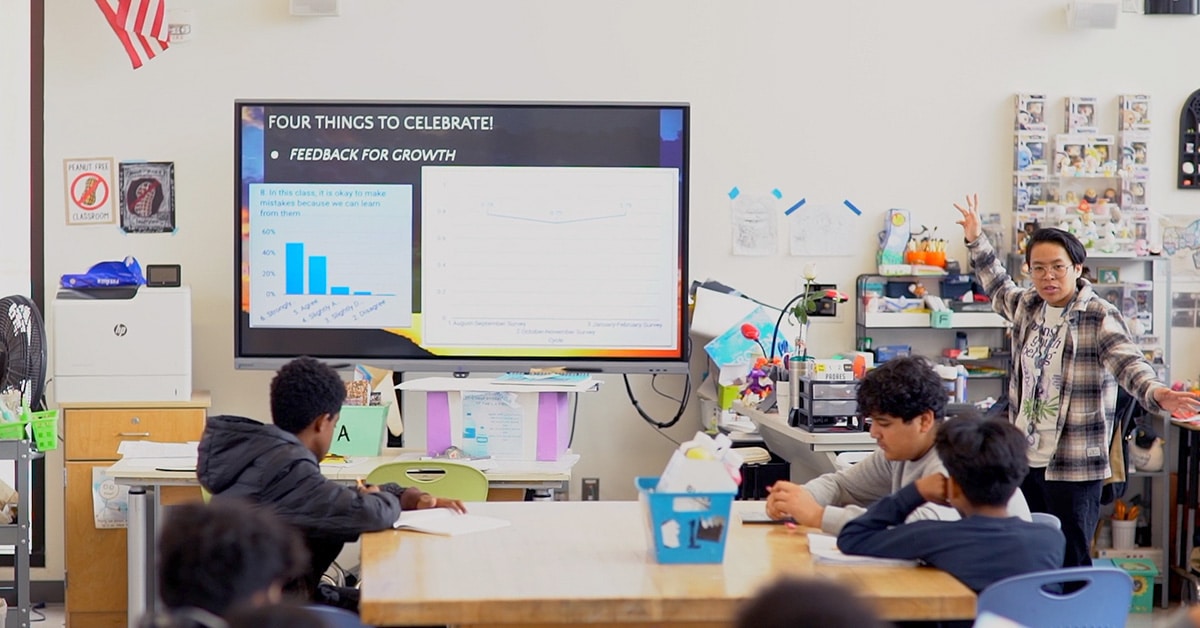- learning, PBL Instruction, project, student, video


This improvement routine has teachers gain insight from a 5-10 minute student survey to share back results to the class in order to strengthen classroom practices that boost student engagement and learning.
Click here to download the protocol document
For more information about the student survey used, click here.
[MUSIC PLAYING] NARRATOR: Here at Wilson middle, teachers in the care network have been collecting student survey data to better understand how students are experiencing their classroom. After collecting the data, teachers share the survey data back with students to demonstrate that, like students, teachers are continuously seeking to improve and grow. Teachers in the care network use a student survey developed by perts at Stanford to measure students’ perception of six key classroom conditions, known to support student success.
MICHELLE CALIMLIM: This is their opportunity to let teachers know how they feel in their classrooms. There are the questions about classroom belonging. There are the questions about feedback, which obviously we all know as teachers are very integral to how students engage with us.
NARRATOR: The insights gained from the 5 to 10 minute survey are used to strengthen classroom practices that boost student engagement and learning. Here are the steps for a queue. Number one, frame the purpose for students. Prior to conducting student surveys, explain to students that the data gathered will be used to improve their experiences in this class.
MICHELLE CALIMLIM: I think this survey is a little bit more focused on the social emotional aspect of the classroom. A lot of data that we collect is are they understanding the content? Did they get this concept? And things like that. But I do feel it’s important to recognize that their understanding of content is also impacted on the way that they engage with us or engage with each other within our classrooms.
MARIA: It was also kind of like weird since I wasn’t used to doing that type of stuff, but then I got used to it. And also like it’s so way you can say how you feel.
NARRATOR: Number two, conduct the student surveys, then reflect on results. Identify four celebrations in the data, two areas for growth, and a question you have for students to brainstorm around. Number three, share this data back with students. Be sure to share one or two concrete things that you are planning to do in a particular area to improve. This can help develop trust and buy in to avoid survey fatigue.
MICHELLE CALIMLIM: When I’m looking at these surveys, I am looking for what I know is directly impacted for the content that I teach and the environment that I’m trying to create in the room.
MARIA: Like it has improved our class since now she knows what our opinions are of the class so she can help us more.
INTERVIEWER: Number four, ask students for their ideas. If you can give students a chance to process this information in small groups and ask them to submit an exit ticket with the prompt. What else should I know? What else could we try?
DIDIER: You could feel appreciated or just happy that we had some improvement and we know we could become better at something we weren’t used to.
MICHELLE CALIMLIM: I think the purpose for me for the four two Qs is to get a sense of maybe what I’m not seeing if I’m so focused on the content, on the art, on the other things that are happening in the classroom. There might be something within my lesson or within the classroom environment that I might be missing.
MARIA: Like now I can be more honest since I saw how they present it. And it doesn’t like it’s not specifically on you, it’s on the whole class.
STUDENT: Yeah, I would say the same thing. My teacher learns about how we are and what she can improve on.
MICHELLE CALIMLIM: With these cards, if anything stood out from period 6 or period 5, I would address as a whole class. If their name was written on the card, I’ll maybe touch base with that student and be like, hey, I’ve noticed that this is what you’ve kind of responded to. I want to work with you to see what other ways we can help make the experience better for you.
NARRATOR: What makes this routine powerful is that the data is being shared back with students, which includes them in the teacher’s inquiry and improvement process.